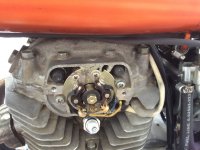Well the answer is not all that simple, but first off the answer is no, a few hundred rpm change is not off base.
Maybe the best thing to say is to work on getting a grasp of what you are trying to accomplish rather than just following the directions on the back of the box.
You want to adjust the ignition first, because that is in the main a setting, not an adjustment. It could be an adjustment, but at least for tuning up a standard engine to start with it is just a setting. You are adjusting two things that are completely distinct, but because of the mechanism, one is affected by the other.
Set the point gap first. In the main, the actual gap is somewhat inconsequential, but because of the way the mechanism works, adjusting the gap controls the length of time per camshaft revolution how long electricity is supplied to your ignition coil, and this is the aim of the adjustment. It is important because if the coil is connected for too long i.e. the gap is small, the coil will get hot. If not long enough, i.e. the gap is too wide, there will not be enough time to build up enough magnetic field in the coil and the spark will be weak. There is a bunch of other stuff, but that gives the jist.
The second thing is to set the spark to fire at the correct time. The coil fires the spark plug when the points break open, not when they close. Once the gap is set, you can move the assembly any where around the cam and fire the plug whenever you want, and the gap will stay the same. However if you set the spark to fire at a particular spot first, and then adjust the gap afterward, you will see that the set point will change. That is why you have to set the gap first, then the timing.
Once you get the ignition set correctly, you can focus on the carburetor(s). These are adjustments, because every engine, even identical ones, are very slightly different and usually need very slightly different fuel and air settings to run the best. These are typically extremely fine tweaks. Your aim in adjusting the air (or fuel) adjustment screw is to fine tune the air/fuel at idle and very slightly above. It is a trial and error process, and often you will make a compromise between the best idle and the response when you just crack the throttles open, so don't fixate on exactly reproducing the manual results. Most bikes have air screws - located on the inlet side of the carb usually. Some have fuel screws located on the engine side. Your goal is to adjust the fuel ratio at idle, so if you need more air, you screw the air screw out to let more in. If you take the screw out, you will see it is shaped like a cone or point on the end. Screw it in all the way, and it completely closes off the air supply to the idle system. As you screw it out, it lets in more and more air. A fuel screw is the same except it controls fuel - if you need more fuel you screw it out. So how do yo know how much fuel or air you need? That is where the increase in rpm's comes in. The manual tells you to start in a specific place which they know will be close, but they know it will only be close which is why it is an adjustment. If it weren't variable between engines and environment, they would just bolt in the right jet. If you have an air screw, run the motor until nicely warmed up, and if everything else is adjusted, you can adjust the idle air supply. As the air/fuel ratio gets leaner, that is, it has more and more air added to it, the ratio will close in on being perfect. As it does, the engine will speed up slightly. Once it gets too lean, it will stumble and try to stall. So back the screw out until it gets highest idle, and at the point it stumbles screw it back in a bit - back into the perfect zone for that rpm. You may need to adjust the idle stop screws afterward to reduce the idle to where you want it. If you do, go back and repeat the process for the air screws. Repeat as needed. The process is the same if you have fuel screws, you just have to realize that with the fuel screws your adjustment is opposite - adjusting the screw in will reduce the fuel and make the mixture lean. Once you get that done, you can ride the bike. You may find that you get better drivability by adjusting the screws in or out a bit to get better off idle response - there is your compromise! So adjust your carbs by the book, but don't be afraid to make minor changes to get the best balance.






